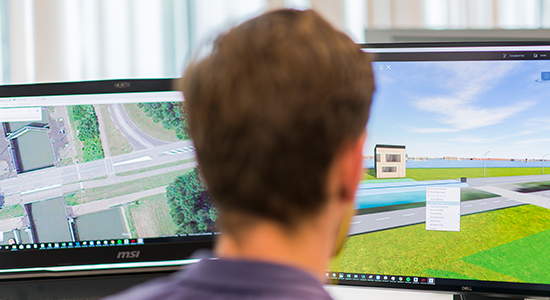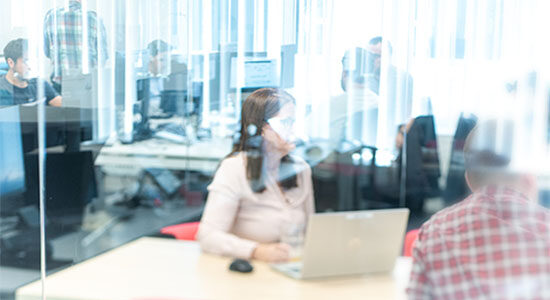Based on their experiences with the Aalter-Beernem project, Angus, Jeroen and Jens are searching for answers.
Infranea deployed a team of six for the Aalter-Beernem project (Belgium), three of whom were full-time: Angus (3D design and BIM coordination), Jeroen (Infrastructure) and Jens (Artwork). We asked them how they work alongside one another as digital engineers, what advantages this delivers for the customer and what we can learn from it for future projects.
The importance of an accurate estimate in advance
As it turns out, Infranea was only included in the design team quite late on in the Aalter-Beernem project, awarded by the client TUC RAIL to BESIX Flanders. The design commission for the construction of a third and fourth track between Ghent and Bruges turned out to be significantly larger and more complex than initially estimated. This was why the client (BESIX – Ed.) was urgently seeking to strengthen the team. “It had to be Infranea,” smiles Angus. Angus, Jens and Jeroen had worked together as a team several times before with BESIX. “They had confidence in us and they knew we could be brought in quickly, thanks to our experience with them on other projects.” It soon became apparently that not only the client, but Infranea themselves, had also underestimated the amount of work. The challenge was to keep the project on the rails…
Back to the drawing board
Particularly in Belgium, it seems the client often still asks for drawings in PDF format. Angus has some understanding for this: “Belgium’s engineers are very smart, but they stick to the idea of laying out drawings on the table to explain to people what needs to be built.” For this project also, the iInfranea team had to finish off the existing designs for infra and artwork and then deliver the drawings. “That was a huge learning process for us as 3D designers,” says Angus. “The major challenge was properly understanding what the client and the principal wanted. We now know how to approach such a process and we can do that very efficiently.”
2D or 3D? That is the question.
The BIM co-ordination was carried out in CAD as there were many drawings that needed to be made. At Infranea, the digital engineers try to do BIM coordination in 3D in principle. “So BESIX decided to fully recreate TUC RAIL’s design in a single integrated BIM model, but BESIX Flanders didn’t have experience needed for that,” explains Angus. Jeroen adds that getting the classical 2D drawings back out of 3D is not as easy as it might sound. “We’ve learned to accelerate that process of 2D to 3D and the other way round, not just in infra but for artwork too,” he recounts. Jens further adds that they prefer to be consulted right from the start of the design process. “Thanks to our experience, we can also be of great assistance in the design phase.” Jeroen agrees that involving Infranea earlier in the design phase would be very helpful.
Four clients for one project
Infranea usually works on large projects in which temporary business partnerships (TBPs) are set up with a range of partners. To clarify this, the gentlemen explain that they worked for four “clients” in total on the Aalter-Beernem project: BESIX NV (artwork design), BESIX Infra (infrastructure design), BESIX Implementation (planning and budgetary control) and TUC RAIL (principal). “We had to keep our own internal management satisfied here too,” say all three with a smile. “And that’s before you include our wives in that,” adds Angus. That provokes a fit of laughter…
Working together remotely
Normally all the project members, and thereby all the disciplines, will be physically together in one large office. This allows you to respond very promptly and take decisions quickly. For the Aalter-Beernem project, it was decided to work separately for all manner of reasons and only meet together once or twice a week. Angus views the challenge in a positive light: “it’s taught us to communicate better with our clients when we’re not sitting down together.” The Infranea team searched for and found innovative solutions for better remote collaboration, both with each other and with the client. Google, for example, offers a great many possibilities for efficient communication via e.g. Meet and Drive.
80% are soft skills
“Soft skills are 80% of the task,” says Angus. “3D Engineering is our field and we’ve got that down pat, but the communication within a community for such a vast project was the real challenge for us.” All three concur that it is mainly about understanding the client’s needs and concerns properly. A difficult balancing exercise of give and take, they admit. Jeroen further states that as digital engineers, they actually always end up doing more than was originally asked: “For example, incorporating traffic safety and maintenance into our design.”
An agile team with a clear structure
“Everything stands or falls on how well you prepare,” says Jens. “Not only as regards the digital element or the model, but estimating the full picture. Patricia was working from our office in Valencia, Jeroen from Hasselt, Angus from Ghent and me from Antwerp. We then found a way of still managing to work together quickly and effectively with one another.” Jeroen further adds: “We always remain customer-focused in this and with our eye on the final result. You don’t see that nimbleness as much elsewhere. As soon as something changes, things can go wrong very quickly.” The Infranea team feels like a fish in water at precisely those moments when a project changes and becomes more difficult, because their passion for digital engineering means that they always look for solutions to the problems that cross their path. A small, nimble team that combines all disciplines with a passion for digital engineering: that seems to be the formula for success at Infranea. Jeroen sees that there are different departments for infra (roads) and civil (artworks) in large companies, for example. At Infranea, those disciplines, along with the skills for the Civil 3D and Revit tools, sit combined within a small team that has learned to work well together. “We try to work in an agile way with a clear structure,” explains Angus.
Learning is a no-brainer at Infranea
“You need to be addicted to brushing up your knowledge,” says Jeroen. Angus agrees with Jeroen: “We get bored very quickly. That means we need constant changes and new challenges. Once we’ve drawn the same thing a few times, we soon get sick of it and look for ways of being able to do that faster and more efficiently.” “That truly is the philosophy that’s typical not just of our team, but of the whole of Infranea,” Jens adds. This is why Infranea works internally, across its projects, with knowledge teams around specific skills. Solutions are sought within those teams for the questions that come in via the projects. Where the knowledge is not in-house, someone will go on a training course, an expert will be recruited or time will be freed up to devise an innovative solution ourselves. This is what characterises Infranea as a networking organisation, with numerous internal and external branchings, which gives it the resilience necessary to respond dynamically to new challenges.

What makes an Infranea team unique?
“I’ve never seen this before in my 30 years’ experience as an engineer,” says Angus. “We’re all passionate digital engineers at Infranea and we succeed in making our jobs more interesting by engineering our own work, you might say. The things nobody wants to do are things that we can do more quickly thanks to innovation, which keeps it fun and exciting.” During the conversation, all three concur that a team at Infranea is a unique formula of different disciplines, experiences, backgrounds and characters too. The passion for digital engineering is the glue that holds the whole thing together.
What are the lessons learned from this project?
As the 3D design manager and BIM co-ordinator for this project, Angus responds: “It’s the first time TUC RAIL has outsourced a commission of this magnitude, so it’s been a learning process for everyone. We’d like to go back and improve the approach a whole lot more when we get the next opportunity – that’s in our DNA. We’ll be devoting ourselves even more, in our advisory role, to keeping the focus on what our client wants for the final result. The question remains, then: “What is it that contributes towards that final result?” All the rest is wasted energy… We need to work together less as two teams and even more as one team.” The team members then share these learning points both internally and with the client in the customary evaluation periods.
What does the future hold for digital engineers?
Jeroen feels there is a tipping point approaching as regards digital engineering. “I’ve been doing this work for 15 years and that’s how it feels, but there’s still some way to go yet. Sometimes a client still wants 2D as a final product, but that’s beginning to change.” Angus adds: “It’s interesting that clients are beginning to ask how they can get more out of our 3D models. They need to start understanding and using our data. Then they’ll start letting go of the drawings and PDFs and run through the 3D models. That opens up a world of possibilities when it comes to forecasting, clash detection, VR, big data, IoT, and so forth. We just have to demonstrate those possibilities and then it becomes clear to the client. Naturally we have to try not to move too quickly. We understand that clients sometimes still prefer to hang a drawing on the wall. Sometimes things can go too fast. We first have to teach the client to walk before they can run.” A few examples follow such as AWV, Aquafin, Infrabel and major European projects that are starting to include 3D modelling as a requirement in their contracts. “So there’s more work coming our way, as classical contractors will now have to deliver a 3D model as well. This is going to evolve even further and faster in the coming years,” concludes Angus.
Any advice for new digital engineers?
Jens sees that many of his younger friends are graduating as programmers or IT specialists, given the onward march of digitalisation. In this, he sees a vision of the future that offers many possibilities in terms of software development for the engineering sector. Angus replies that he sees a new generation of digital engineers who can work lightning fast with computers, but the technical expertise with design will remain essential, along with the skills to fathom what the client’s expectations will be. Jeroen adds: “Listen closely to the expectations. You can do your own thing, even in circumstances that are constantly changing, but there are a few structures and logical principles that you have to keep applying – regardless of which tool you’re using.” Jens formulates it as follows: “If you want to shoot your bow and arrow, then take the time to aim well first. It doesn’t matter if the arrow misses the bullseye – the team at Infranea will devise solutions to get the arrow back on course.” With these telling tips from three wise digital engineers, we round off the interview.
20/06/2019



